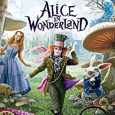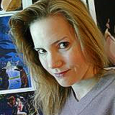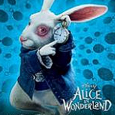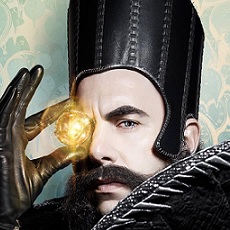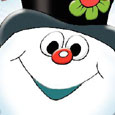Walt Disney Pictures (March 5 2010), Walt Disney Home Entertainment (June 1 2010), Blu-ray plus DVD and Digital Copy, 109 mins plus supplements, 1080p high-definition 1.78:1 widescreen, 5.1 DTS-HD Master Audio and Dolby Digital, Rated PG, Retail: $44.99
Storyboard:
Alice drops back down the rabbit hole to Wonderland and finds all is not as she remembers…
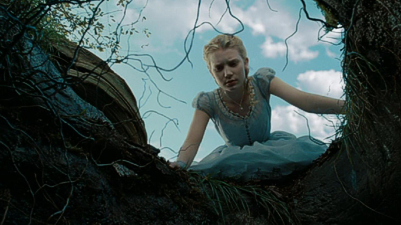
The Sweatbox Review:
Naturally, when joining up the name “Walt Disney” with the title “Alice In Wonderland”, the 1951 animated feature film of Lewis Carroll’s very whimsically British novel comes immediately to mind. But with this latest version of the story, another name has squeezed itself in-between the two, and provided some other twists of his own: director Tim Burton. It’s interesting to see the insertion on the original posters and now the home video packaging, since often Disney very much likes to remain the only recognizable brand, the signature squiggle being a sign-off, or stamp of approval, on a quality product.
But it seems the Studio puts just as much faith in Burton’s name, unlike, perhaps, other recent directors that have returned to the Studio to produce high-profile digital or 3D movies – the most obvious example being Robert Zemeckis, who strangely never got the Burton-level contractual credit on A Christmas Carol. In some ways I can see the need for clarification: marking out a new release as “A Film By Tim Burton” indicates, for one, that this isn’t the classic Disney Alice and, two, by now the audience is so attuned to what Burton usually serves up, that not having his name above the title could amount to complaints from some audience members not receiving their expected dose of darkly-lit gothic light.
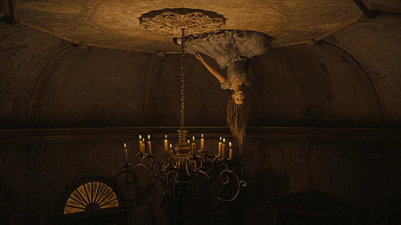
On one side there are those that do complain every Burton film has too many similarities; on the other there’s a vast majority (going by the success of his films) that know exactly what they will find, and indeed expect a certain style and experience. It’s that success that has allowed Burton to uniquely become one of the most original voices in filmmaking, and a director who can master multi-million dollar blockbusters with the voice of an independent artists. Yes, Burton’s films all follow the same path, but who else in Hollywood makes films as rich and different as he does, with the undoubted audience appeal (over $1 billion alone for Alice), from practically everything else out there?
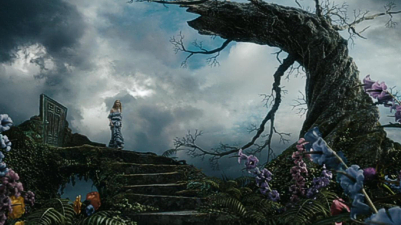
Part of the appeal is his leading man, of course, and both Johnny Depp and Burton’s careers owe a great deal to each other’s. Here, after the immense success of the Pirates Of The Caribbean movies, Depp’s is another name that gets top billing, even though he’s notionally performing in nothing more than a supporting role, something that I personally found quite naughty but fun. In many ways, Alice In Wonderland brings things full circle for Burton, who started as a Disney animator in the early 1980s but found his weird and warped view on things cracked under the pressure of drawing cute and cuddly critters for the likes of The Fox And The Hound. Burton got to use his talents on projects more suited to his nature (The Black Cauldron, Return To Oz) before being unleashed on the short film format with the personal short Vincent and the half-hour mini-movie Frankenweenie, which caught the attention of Paul Reubens who requested him to direct the theatrical Pee Wee’s Big Adventure.
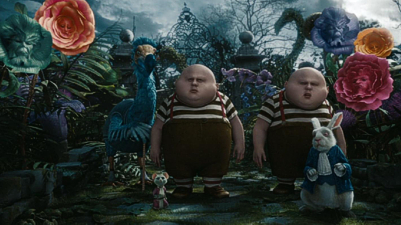
Burton was pleased to break out of Disney’s, going from one often hellish take on a subject to another, and breaking box-office records along the way, before a revitalized Disney called him back to produce the landmark The Nightmare Before Christmas, a typically macabre take on the holidays which has become a big cult hit since its release in 1993. A number of collaborations followed: there was another stop-motion film, James And The Giant Peach, another personal black and white feature, the exceptionally brilliant Ed Wood, and an intended crowd-pleaser, the underrated Cabin Boy, which really is worth a look if you can find it.
Since then, the director has bounced around studios, some of which understood him (returning to Warner Bros., the Studio that had nurtured his early big screen ambitions, for the weird and wonderful Mars Attacks), and some that didn’t (the “re-imagining” of Planet Of The Apes for Fox being a career lowpoint). In recent times, Burton has attempted to stretch out with Sleepy Hollow and Sweeney Todd: The Demon Barber Of Fleet Street, pretty edgy films that he intersperses with more routine family fare. When first announced, Alice In Wonderland sounded like it might follow along the lines of another of Burton’s adaptations of British writing, Charlie And The Chocolate Factory, in which Depp played Willy Wonka.
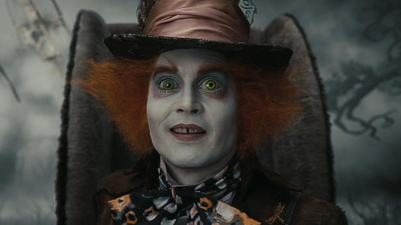
That movie, in its attempt to be something other than a rehash of the 1970s Gene Wilder favorite, was in many ways a dud, reverting back to Roald Dahl’s original novel in so many ways that it ultimately struggled to bring anything new to the already quite perfect original, and forced in an absolutely unnecessary sub-plot about Wonka’s ageing and father complex. In many ways, and with a second Wonka book ready to be filmed, I wondered if they weren’t all just going through the motions to kick-start a new Wonka franchise, but as yet Charlie And The Great Glass Elevator has yet to be announced as a Burton/Depp movie. Instead, they’ve teamed up for a loose translation of Lewis Carroll’s curious and curiouser book, and the results are far more pleasing than one might expect.

The trick is in the basic concept: this isn’t Alice In Wonderland at all, but rather a sequel of sorts, catching up with a now teenaged Alice on the cusp of womanhood and having to make all kinds of decisions under pressure. Of course, being a Burton Alice, she’s an outsider, unable to make what others may presume is a simple jump to adulthood – and the prospect of marriage – without first experiencing the right kind of events to give her some perspective. In many ways, what Burton, and his screenwriter, Beauty And The Beast’s Linda Wolverton, have concocted is an amalgamation not just of Carroll’s making, but a little of JM Barrie and L Frank Baum as well.
For Alice, like Peter Pan’s Wendy, finds the answers to what she has been asking herself after her extraordinary adventure, which may or may not be a dream, but provides the emotional ingredients she needs to find within herself that supplies the confidence for her to return home and face the future on her terms. She does this via another trip down the rabbit hole, leaving the guests at an important party after she spies the White Rabbit that led her on her first encounter to Wonderland many years ago. Coming just at the right time, it’s clear that the sighting of the Rabbit is probably an apparition that Alice dreams up herself in order to cope with the pressing questions she knows she will be faced with at the party, in the same way that Dorothy ultimately creates the land of Oz subconsciously to deal with her frustrations and concerns in Kansas, as well as allusions to variations on characters appearing in both “realities”.

Actually, Baum’s Oz books, specifically the two used as the basis for Disney’s 1986 Return To Oz film, are a pertinent aspect to bring up again once we reach Wonderland too, for now instead of the bright and wacky land of nonsense we usually associate with the place, Burton’s influence has seen to it that Wonderland has, in the intervening years since Alice’s last visit, become a vastly undernourished, drab and dreary territory now nicknamed Underland. In fact, it hit me on several occasions that what Burton and Wolverton have managed to do here is to create an authentic reworking of a classic and pulled off what couldn’t quite be done with Return To Oz: they’ve actually pulled off a successful version of Return To Oz.
As such, and indeed if there’s anything wrong with this different take on Carroll’s material, it’s that they’ve stuck to the title. Perhaps the earliest intention was to make another straight version? But goodness knows we’ve already had more than enough of those (from the 1915 silent film, through Walt Disney’s 1920s Alice’s Wonderland shorts series and Paramount’s all-star 1933 talkie, with an animated segment from Leon Schlesinger, to multiple television and international versions throughout the 1960s, 70s and 80s, including Czech artist Jan Švankmajer’s creepy and surrealistic part stop-motion 1988 fim), and how much better than Disney’s classic 1951 attempt or the well-regarded 1972 live-action version featuring another all-star line up could it be?
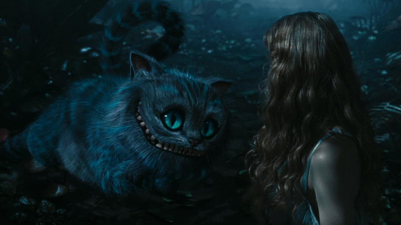
Well, just like Spielberg knew he couldn’t better the greatness of Walt’s 1953 animated take on Peter Pan (and unfortunately couldn’t even match it with the sporadically excellent but overlong and intricate sequel Hook), Burton’s film picks up after Alice’s original adventures in Wonderland. And although it does recycle some similar other return visits, it’s a clever concept, allowing the filmmakers free reign over the material without tarnishing its memory: the very worst thing would have been a bad Tim Burton version of Carroll. Disney’s earlier edition famously drew the ire of the critics, and even Walt himself was said to be displeased with the jumbled result even if Ward Kimball and the other animators appreciated the knockabout style (more akin to a Warners cartoon) that gave them a chance to break loose.
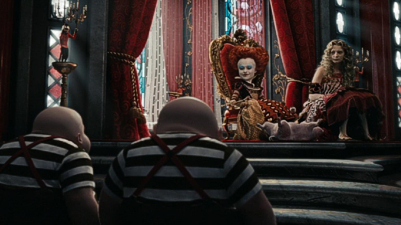
Disney’s 1951 film was actually a muddling of Carroll’s two books, Alice’s Adventures In Wonderland and Through The Looking Glass, drawing on characters from both and, in the attempt to produce a freewheeling comedy that audiences would perhaps expect given previous screen versions, leaving some of the most dark and disturbing elements out of the picture. The Studio has never been against reworking some of its titles (remember that the 1973 Robin Hood raised some eyebrows since Disney had already covered that story with a live-action Richard Todd adventure in the 1950s), and Burton’s follow-up certainly feels for the most part like a specific continuation of the Disney version as opposed to any other (although, the live-action influence of the all-star 1972 Fiona Fullerton edition is perhaps just as felt and ever perhaps more of a companion).
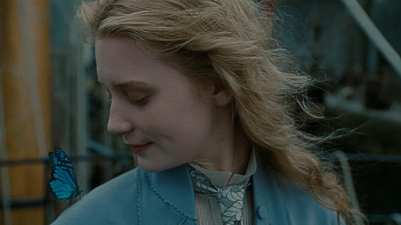
Which is why that title just doesn’t work, or actually do the movie justice. Early press materials were at pains to explain that this was a continuation, even if the title alluded to something different. Perhaps the more obvious Return To Wonderland was deemed too close, considering the gloomy Underland elements, to Disney’s Oz sequel, a box-office flop routinely though unfairly condemned as everything that was bad about Disney in the early 1980s. However, it seems the Studio marketing won through, and although Alice In Wonderland isn’t a “does what it says on the box” label, Burton throws in enough elements from that story so as not to let anyone feel cheated.
Somewhat supporting the notion that things feel like a sequel to a meld between Disney’s 1951 film and the 1972 version are the absolutely stunning visual effects. Alice is Burton’s first motion-capture enhanced film, though for those worrying that this might mean more of the lifeless eerie mannequins of The Polar Express or A Christmas Carol, worry no more! As an animator, Burton completely understands the workings of the medium and, even in the digital realm, knows what is and what isn’t working. As such, some of the animated characters from the 1951 film basically appear with a CG makeover, while others seem to be more derived from the 1972 edition, though they all mesh well with each other.
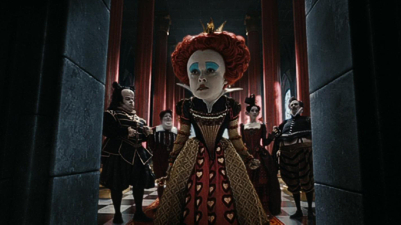
Helping these along are, as appears to be par for the course with Alice adaptations onscreen, a line up of recognizable names and faces, with Depp coming top of the billing even if he essentially plays second (or third) fiddle to newcomer Mia Wasikowska as our title heroine and Helena Bonham Carter as the devilish Red Queen. Wasikowska is a real find, not only beautifully charming in her looks and manner, but able to carry off the child/young-lady kind of tone that this version of the character needs to inhabit. Bonham Carter is more one-note, but then again that’s her character, and she plays the diminutive but overbearing Queen just right, with a unique melding of mo-cap and live performance that brings her to life with practically seamless effects in her elaborately decorated castle (another nod to Disney, with its heart-encrusted silhouette suggesting not a fairytale, but the breaking up of a bitter and twisted relationship).

In his many but often brief scenes Depp, who I personally believe is the best screen actor/chameleon working today, matches the rest of the cast (including Michael Sheen as the Rabbit, Barbara Windsor as a now female Dormouse) as only he can, bringing a spot of Edward Scissorhands to his mentally disturbed Mad Hatter. Indeed, even back in the theatrical release, I was surprised when many critics totally missed the point of his performance choice to switch into a wild Scottish brogue (not very dissimilar to that of a hyperactive Captain Jack Sparrow) whenever he spoke of bringing down the Red Queen and restoring the Wonder to Underland.
Surely this is a not-so subtle nuance that plays up the difference between the rather meek and weary Hatter, damaged after years of oppressiveness, and his inner flashes of bravado, where he thinks he can take anyone on? “I don’t like it in here, it’s terribly crowded”, he tells Alice poignantly at one point, further confounding me as to how anyone could have missed this clear signposting to the fact that this poor individual has quite literally driven himself “mad” to the point of schizophrenia? It’s a quite wonderful thing to find in a mainstream commercial movie, and one ostensibly portraying itself as fun for all the family, but thus is the genius that sparks when Burton and Depp find themselves firing on all creative cylinders.
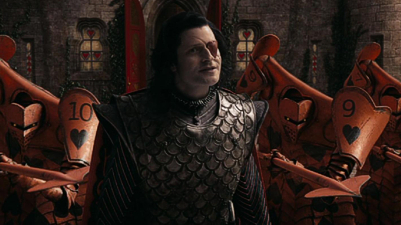
Of the rest of Alice In Wonderland, it really is all quite wonderful. There’s never any doubt that we’re in either one of Carroll’s or Burton’s worlds, and despite the changes from the director’s influence, there’s a meeting of minds, as it were, that crosses any boundaries. A clever trick has Alice forgetting that she had ever dropped into Wonderland before, allowing her to go on essentially the same trip albeit from a different angle, and Burton’s takes on the Tweedles, Dum and Dee, might strike one as exactly as the two characters should always have been portrayed (another almost invisible matching of CG animation and live performance, by Matt Lucas, playing both). The character of Pugsley, from Charles Addams’ The Addams Family immediately sprung to mind, and it makes the promised Burton version of that comic strip an enticing treat to look forward to!
New Burton regulars Alan Rickman and Timothy Spall also make the voice cast, though it’s nice to see another (and more prominent) role for Crispin Glover, the original George McFly and an actor who has had his fair share of a bumpy career but seems to have bounced back after a number of small but noticeable appearances, most notably in the wickedly amusing remake of Willard and as Grendel in Zemeckis’ Beowulf. That film gave him the basic training in the mo-cap technique and he puts it to good use here, performing as an elongated henchmen to the shrunken Bonham Carter in another visual flourish that, while it is sometimes the most unconvincing effect in the film, lifts the work of Sony Imageworks, under the supervision of ex-ILM visual wizard Ken Ralston, to new heights.

I have to say that, despite their undoubted success, I’ve never always been too impressed by Imageworks’ output, and have been surprised to find the meticulous Ralston at the helm of some questionable visual effects shots of the kind that I don’t think would have passed muster back at ILM, but here he pulls everything out of the hat to provide a mostly seamless and consistent visual approach between the practical performers and effects and the CG trickery. On the sound side of things, everything is tied together with a typically embracing score by Burton’s regular composer Danny Elfman, who as well as his usual approach brings several new colors to his cues, especially those for Alice in the opening scenes, the Red Queen and the Hatter, and a terrific end credit arrangement that may recall several of his trademark musical quirks but is relentless all the same (arriving after an awful Avril Lavigne track that comes crashing in and begs the question of what they thought they were doing, ruining the period atmosphere).
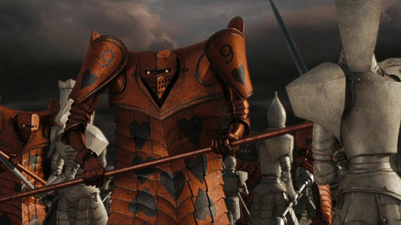
Far from being a “greatest hits” collection of what we usually expect from Tim Burton’s films, Alice In Wonderland manages to bring a new, different take on a well worn story without cancelling out either Carroll’s original structure or, well, what we usually expect from a Tim Burton film. Most uniquely, it feels entirely fresh, and its phenomenal box-office success is well deserved, and proves that there are a lot of people out there that probably share even an ounce of the director’s vision. I don’t think Burton has ever made a bad, bad movie, which makes picking the best of the bunch a trickier proposition than with most director’s work. But Alice, even forgiving the mis-title, is certainly way up there, with all the whimsy of Carroll’s work given a big budget, glossy sheen combined with the unique slant that only Burton seems able to create.
Is This Thing Loaded?
With a box-office take exceeding a billion dollars, you might expect Disney (of all companies) to hold back on an all-singing, all-dancing disc set in favor of putting out a set slim on features only for a double-dipping opportunity to come along down the line. Well, it’s no surprise that Disney will probably release another edition if and when 3D does take off for the home market, but for now, and far from attempting to swindle fans out of their hard earned cash, the Studio has seen fit to pack Alice In Wonderland with a (albeit shallow) rabbit’s hole worth of extras. A triple-disc combo pack, the set includes the movie in Blu-ray, DVD and Digital Copy formats.

On the Blu-ray Disc, the usual barrage of Disney previews play (though can be skipped by going direct to the absolutely gorgeous main menu), featuring generic a Blu-ray spot and trailers for the hyper next-Potter/Percy Jackson Bruckheimer/Cage collaboration, the quite bonkers looking but possibly brilliant The Sorcerer’s Apprentice, Tinker Bell And The Great Fairy Rescue and a Pinocchio anti-smoking spot. From that aforementioned fantastically presented main menu, an additional Sneak Peeks option holds anti-piracy and Disney Movie Rewards spots, Beauty And The Beast (in plain-old 2D before we’re asked to see a theatrical reissue again next year and then buy the inevitable 3D disc!), James And The Giant Peach: Special Edition, the much delayed Fantasia collection (and hey, while I think about it, just where the heck is Dumbo!?), and a promo for the Disney Parks.
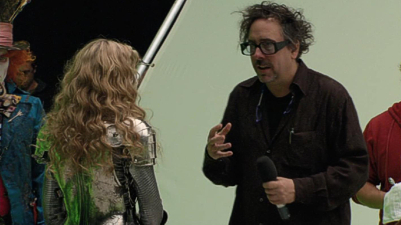
Alice’s supplements themselves have been split into two sections: Wonderland Characters and Making Wonderland, each holding six behind the scenes featurettes apiece. There really is a wealth of material to go through here, with the Characters featurettes lasting well over 27 minutes in their Play All configuration and providing an exceptional look at the personalities on display in the film, from their conceptions from Carroll’s books through Burton’s design filter, the casting and portrayals of the actors involved. Finding Alice (5:24) looks at Burton’s vision for the title character and how Wasikowska adapted to the challenges of the role; a clear indication as to why the film is so successful as it is lies in what the many talking heads say: they’re all totally tuned into one another and the themes of the story and make many insightful observations.
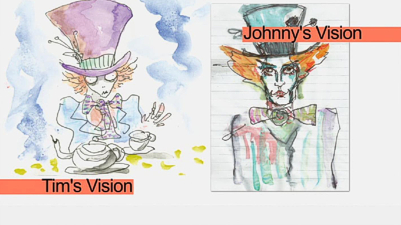
The Mad Hatter (6:02) explores Depp’s take on the quite literally “mad” character, with the actor expressing his desire to portray the poor soul as someone driven insane by the craziness of Wonderland. Featuring his process of discovering the character from Depp’s own initial watercolour images through to the digitally enhanced and enlarged eye lenses he wears in the film, there’s also a helpful elaboration on Depp’s schizophrenic choices to the character. The Futterwacken (3:22) looks at the supposedly crazy dance that is a favorite of the Hatter’s, although for all the obvious hard work gone into its creation, the eventual – and much hyped – moment in the movie isn’t anywhere quite as loose and wacken as the name suggests, the biggest reveal here being that Depp was replaced by a professional “futterwacker” for those scenes.

The Red Queen (5:57) again goes from Carroll’s concept to Bonham Carter’s screen creation, delving into how she was amused when Burton first cast her to how the effect of her character’s extraordinary large head was achieved as a later enhancement to her practical on-set performance. The design of that large head was the result of many hours of make-up, and a Time Lapse: Sculpting The Red Queen clip goes some way to showing what Bonham Carter had to endure each morning before filming could begin (as Anne Hathaway, as the White Queen, says, everyone else came to set long after Bonham Carter’s make-up session was underway), compressing over three hours into two and a half minutes. Finally, Hathaway’s The White Queen (4:28) gets the same treatment, speaking to the actress and crew on the development of her character.
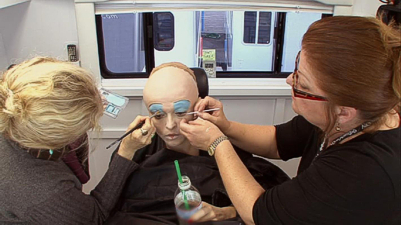
Over in Making Wonderland, the featurettes focus more on the technical side of the film’s production, with another six examples revealing the tricks that went into creating Burton’s vision (with one odd moment revealing a quick shot of a clapperboard listing the title of the film as “Gurgles”!), running a Play All length of over 19 minutes. Scoring Wonderland (3:09) is a very welcome look at the director’s composer of choice, Danny Elfman, who is as much a part of Burton’s films as he is himself. Composers never get their due, as far as I am concerned, in behind the scenes material, but perhaps of their long collaboration and friendship, Elfman seems more prone than most to pop up in a Burton film’s disc supplements, which is always a treat as he’s one of my favorites and the music he’s come up with for Alice is among his best.
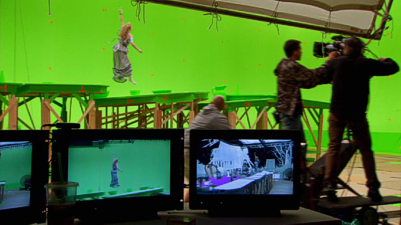
Effecting Wonderland, which as you would expect from its title is an exploration of the film’s immense amount of computer graphics visuals work, isn’t nearly as in-depth as I’d hoped for. At only seven minutes, there just isn’t really the time to go into the logistics and solutions used to mesh live-action performers, keyframe animated CG characters and hybrid characters, which is a real shame since this is one of the most potentially interesting areas ripe for discovery. Only through catching occasional shots of Matt Lucas or Crispin Glover in their green screen suits and wearing height-increasing stilts do we get a vague idea on how their eyelines were achieved during filming before their characters were composited in later, which also goes to explain how Glover’s character in particular sometimes looks a little unsure on his feet.
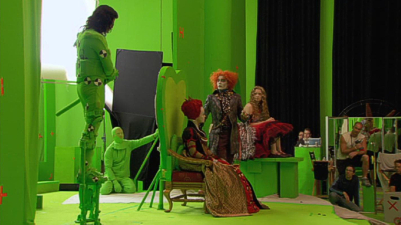
However, although this clip plays at roughly twice the length of the majority of the others, we only get tantalising glimpses of how the Red Queen’s huge head was expanded from Bonham Carter’s body, or how the Bandersnatch was animated (but nothing on the Jabberwocky), and although there is a little more on how Lucas was duplicated for his dual roles as Dum and Dee, this is disappointingly light, especially without the added interest of a picture-in-picture commentary track. Stunts Of Wonderland (2:32) concentrates on Wasikowska’s experience on set as she engages herself with the perils of green screen performance in a flying harness and dealing with the challenges of swordplay, though again the flashes of set footage combined with the talking heads is lighter than hoped for.

Going back to the visual effects side of production, Making The Proper Size (2:12) takes a closer look at Alice’s changing proportions during the story and how those various transformations were achieved, though again it’s tremendously brief, explains little and is mostly full of finalized shots from the movie. Not all the effects in Alice were created later in the digital realm, and the final pair of featurettes look at a couple of the on-set practical elements, starting with the Cakes Of Wonderland (2:33), where the Cake Divas team explain how they went about providing Burton’s team the various scaled “Eat Me” concoctions. Lastly, Tea Party Props (2:03) continues along the same vibe, illustrating how the various tables were decorated with cups, saucers and other elements to create the right look. After a couple of minutes, there’s more than enough information given on these two rather obscure aspects – if only all the featurettes were as dedicated as these ones!

On the DVD, the supplements have been understandably scaled back to give the movie room to breathe on the disc, though there’s no real reason that a few more featurettes couldn’t have been included. Since it acts like an introductory overview, you’ll find the Finding Alice piece on the disc, along with the obvious inclusion of The Mad Hatter, promoting the film’s star name in Johnny Depp. Perhaps chosen because it’s the most substantial, if not nearly as comprehensive as it should be, featurette, Effecting Wonderland’s coverage on the digital trickery is the only other selection to be found, although also repeated are a handful of the Sneak Peeks from the BD disc. While neither disc is as skimpy as they could have been, there’s still the feeling that Disney may be holding back more material for a later (3D?) release down the line.
Case Study:
Amusingly, given Burton’s visual approach and the underlying Underland themes in the movie, Alice was sold in the bright and colorful tradition of previous outings, a cue that the home video packaging (across single-disc DVD, Blu-ray and Combo Pack releases) continues. So, in addition to Disney’s usual blu-rimmed front cover, the rest of the sleeve screams “fun” and “quirky”, emphasized further on the ultra-glossy, ultra-embossed slipcase that also contains “hidden” augmented reality functionality when held up to a webcam unlocks additional behind the scenes video clips.
Inside, there unfortunately isn’t anything as obvious as a Chapter Index printed on the reverse of the sleeve, but there’s a revamped promo insert for the Movie Rewards program (to match their hideous new website – ouch!) and another promo booklet that pushes A Christmas Carol and Disney Blu-ray amongst other titles. The triple disc case retains the platters, all of which promote Depp’s role in the film, in individual trays, including the standard definition Digital Copy disc that contains the film only for portable devices in iTunes and Windows Media formats.
Ink And Paint:
If there’s one aspect that the supplements make abundantly clear, it’s that Alice In Wonderland is practically an all-digitally animated film, and given the audience trend for eating up 3D films at the moment, you’d have thought the film might have been prepared with this presentation from the outset. In fact, although it was released to theaters in 3D, Alice was retro-fitted Clash Of The Titans style as opposed to being shot in the format a la Avatar. This doesn’t seem to have been as criticised as much as it was for Titans, and many pundits suggest that the strength of the 3D had much to do with the film’s theatrical success (Disney’s fourth highest grosser ever and counting). I’m not a 3D fan to begin with, and certainly didn’t see Alice In Wonderland as such in the theater.
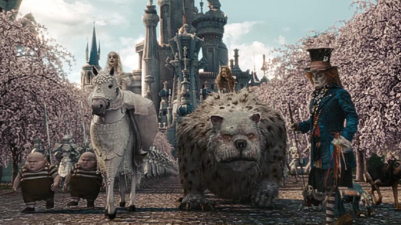
I don’t think a gimmick should provide the enjoyment of a film, especially one, like Alice, that already has many wild and wondrous visual embellishments of its own. In short, all the whooshing and fly-bys in the world wouldn’t have made the dull storytelling of Avatar any better, and it has to be said that I immensely enjoyed Alice In Wonderland just fine without any of these bells and whistles. In fact, given the improvements of the hi-def Blu-ray format over most cinema screen projections, I actually found I liked the movie even more this second time around, with the image providing a depth and clarity that a standard film transfer could only usually dream about. I can’t imagine how disconnected the Cheshire Cat’s disembodied head, for example, might appear in three dimensions, and with everything going on in Wonderland as it is, this elaborately rendered image, which retains a healthy level of film grain, should provide all the visual experience needed.
Scratch Tracks:
Easily matching the visual depth is the excellent DTS-MA audio track, which nearly blew my speakers apart on a couple of occasions! As well as adhering on and off to Carroll’s plots, Burton and Wolverton’s Return To Oz storyline finds time for a few action orientated moments, and these will really shake up even an average home theater set up. But it’s also deliciously warm in the quieter scenes, with the sometimes (intentionally) quiet dialogue coming through clear and distinct. A bit more action would give it a top score, but there’s really not much more to say about the mix than that: it’s a top of the range, high-powered soundtrack that compliments the unique images very well. English Descriptive, French and Spanish alternatives are all optional, in Dolby Digital 5.1, with the same choices available as subtitles.
Final Cut:
I’m not sure why Tim Burton’s Alice took an on-off mixed critical lashing on theatrical result, but the $1bn box-office take should prove that audiences didn’t share those opinions. As a modern take on Lewis Carroll’s tale, I’m just glad they didn’t try and update it to reflect too many contemporary traits; despite still being set as a period piece, this isn’t the Disney Alice In Wonderland you remember, and all that’s really been brought up to date is the state of the art filmmaking sensibilities (including, it must be said, a couple of slightly “gory” moments). With terrific CG enhancements that firmly place Burton’s film in the same leagues as the best of Disney’s other current fare, and a could-have-been-excellent home video package that falls short in the lack of depth or a commentary from the director, this particular trip down the rabbit hole to Wonderland is simply futterwacken wonderful.
 | ||
 |


